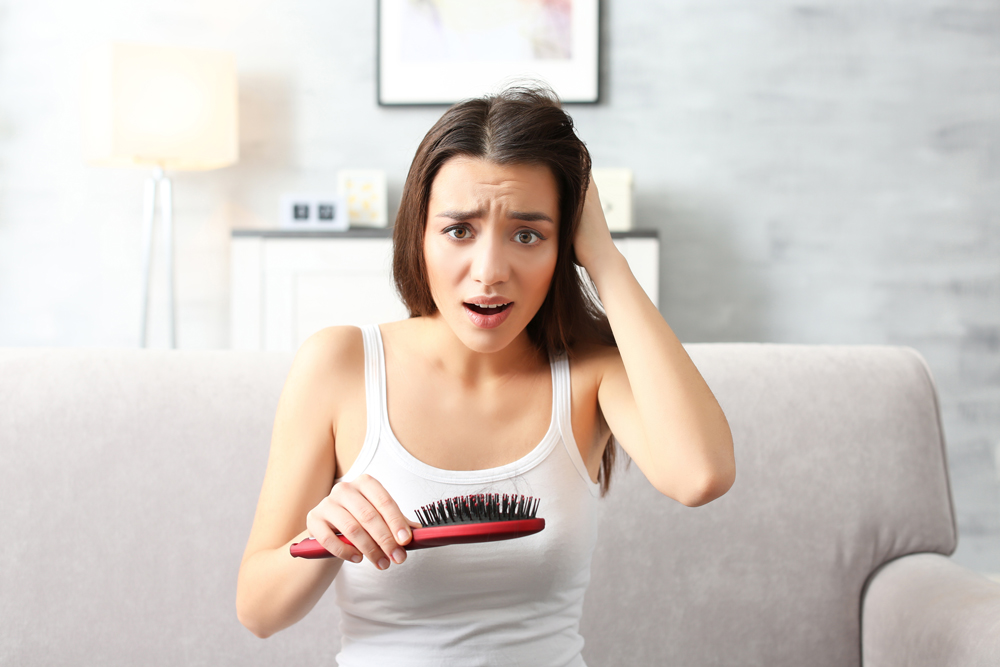Truths and myths about hair loss
If you are struggling with the problem of hair loss, you have certainly come across a lot of information about this problem which has turned out to be false. What is the truth and what is the myth?
You can become bald from stress.
Of course! Cases of sudden hair loss after trauma or severe stress are known. There is even talk of psychogenic or telogen alopecia — stress leads to inflammation of the hair follicle and disrupts the physiological life cycle of the hair, causing more hair to pass from the growth phase to the resting phase (telogen) and eventually falls out. It is believed that stress is the main cause of alopecia areata — an autoimmune disease that affects not only adults but also children.

Diet has a big impact on the condition of your hair.
Of course! Supplementation — a supporting component in treatment — is indicated regardless of the cause of hair loss. A diet low in vitamins (especially from groups B, A, and C) and microelements (especially iron, zinc, magnesium, selenium, and biotin) quickly results in hair loss. Therefore, watch out for restrictive diets or so-called mono diets, because they can affect the condition and appearance of the hair.
Treatments such as mesotherapy only inhibit hair loss while they are being used.
In a sense, yes. Their purpose is to nourish and stimulate the hair follicles to produce new, healthy hair, and the hair is “living” its cycle all the time. However, these treatments are not required on a continuous basis. We recommend a series of treatments once a year — e.g., 3-4 treatments spaced 1-2 weeks apart. You can also have the so-called refresher treatment once every six months, for example. An individual therapeutic plan is prepared during consultation with a specialist.
Not everyone can grow long hair.
Yes, you have certainly heard of people who did not cut their hair, and yet they were not able to grow it to their desired length. It is possible that for some people the hair growth phase is genetically shortened. (On average about 85% of all hair on the scalp is in this phase at the same time.) The reduced period of growth causes the hair to go into rest and the falling out phase more quickly — before it reaches the desired length. In this case, hair follicle stimulation treatments, such as mesotherapy, platelet rich plasma, or stem cell injections are helpful.
Tip cutting accelerates hair growth.
This is one of the most common hair stereotypes. By undercutting strands of hair, split ends are eliminated, which refreshes the hairstyle and makes the hair appear thicker. However, this is an optical effect, not a real effect.
Liquids and tonics for hair growth can replace treatments in the clinic.
There are many ready-made preparations on the market that promise to improve the density and quality of hair. We recommend some of them in our clinic — e.g., Japanese Kaminomoto herbal tonic with plant extracts that stimulate the growth of so-called baby hair and inhibit hair loss, as proven by research. Remember, however, that treatments such as mesotherapy, delivering ingredients subcutaneously in the area affected by alopecia, work more intensively than products applied topically. The best effects are brought by combining these methods and comprehensive stimulation of the hair follicles. Toners and lotions should be used between treatments to maintain the effects.
Hairdressing treatments can cause hair loss.
Yes, although here we are talking more about weakening the hair structure, which causes more brittleness than loss. Aggressive chemical treatments, such as permanent waving (fortunately less often used now),dyeing and strong bleaching, hot straightening (high temperature damages keratin), etc. may also permanently weaken the hair.
Daily hair washing intensifies hair loss.
About 100-150 hairs fall out naturally every day, but the frequency of washing the hair has nothing to do with the intensity of this process — unless you tug on it hard and pull it out when applying shampoo or combing. Hair should be washed as often as required, as having a greasy scalp promotes blockage of the follicles and the development of the yeast responsible for dandruff, which can increase the problem of hair loss.




